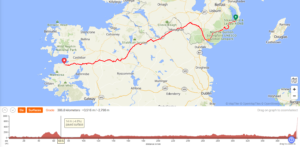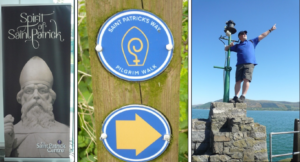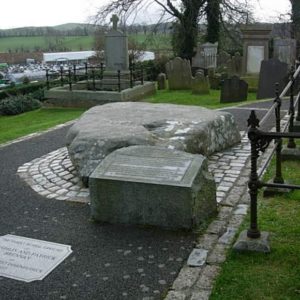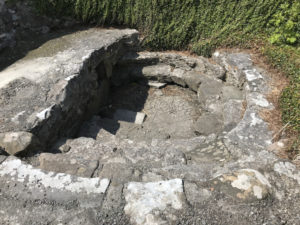Mayo Endurance Enthusiasts Take on the Ultimate Pilgrim Cycling Challenge Following St. Patrick’s Footsteps
Watch the Raceface team journey across the country on the Saint Patrick Way: https://youtu.be/YckUU5OsaLs?si=t-LNO1m1OaJezHIC
A group of former sportsmen from Mayo, under the name Raceface, are gearing up for a new challenge that blends spiritual adventure with history, deeply connecting them to Ireland’s rich heritage. The group is embarking on a unique cycling pilgrimage, tracing the footsteps of St. Patrick across Northern Ireland and Ireland. This epic journey, covering over 400 kilometers, is no ordinary cycle. It’s a challenging route that touches fourteen significant sites linked to St. Patrick, potentially paving the way for a future Irish Camino connecting the North and South of the country.
Cycling through the heart of Ireland’s spiritual and historical landscape, the Raceface group will visit key locations such as Saul, Downpatrick, and Armagh before tackling the final ascent up Croagh Patrick, Ireland’s holiest mountain. Along the way, they will immerse themselves in the rich history, breathtaking scenery, and profound sense of accomplishment that comes from conquering St. Patrick’s Way.
This challenging route, stretching from County Down to County Mayo, highlights major sites in each county along the way, including:
- Strangford Lough, County Down: Where St. Patrick first arrived in Ireland.
- Saul, County Down: The site of St. Patrick’s first church and his burial place.
- St. Patrick’s Grave, County Down: The final resting place of the saint in Downpatrick.
- St. Patrick’s Cathedrals, County Armagh: The ecclesiastical capital of Ireland.
- Jaundice Well, Drumcru, County Monaghan: A historical well with ties to St. Patrick.
- Cathedral of Saint Patrick and Saint Felim, Cavan Town: A cathedral rich in religious history.
- Rathcroghan, County Roscommon: A site synonymous with the ancient kingship of Connacht.
In Mayo, the challenge continues with visits to:
- Knock: The site of the famous Marian apparition.
- Mayo Abbey: A historic site with links to early Christian Ireland.
- Clogher Forge: The starting point of the Clew Bay Heritage Trail.
- Ballintubber Abbey: Renowned as “the Abbey that refused to die,” linked to St. Patrick’s pilgrimage.
- Boheh Stone: An ancient site with views of Croagh Patrick.
- Kilgeever Abbey: A monastic site on the path to Croagh Patrick.
- Croagh Patrick: The mountain where St. Patrick fasted for 40 days and nights, marking the culmination of their journey.
In a special tribute, the Raceface group will retrace St. Patrick’s steps by cycling the 400 kilometers over two days, raising funds for the local Order of Malta, which is in dire need of a new ambulance. To honour this journey, the cyclists will collect a shell at Strangford Lough and a symbolic item from each site (hopefully some shamrock), bringing them to their final destination at Croagh Patrick as an offering to St. Patrick.
This pilgrim challenge is not for the faint-hearted and, as far as we know, has never been cycled before. It promises to highlight Ireland’s stunning beauty and offer a profound connection to its rich spiritual history.
For more information on how to support this incredible journey, please contact: info@raceface.ie
To donate to the Order of Malta, click here: : https://gofund.me/
To follow the team, check here: https://www.facebook.com/racefaceevents

Saint Patrick’s Way: A Pilgrim’s Guide
Welcome to Saint Patrick’s Way, a 400-kilometer journey tracing the steps of Ireland’s beloved patron saint. This route connects Downpatrick in County Down to Croagh Patrick in County Mayo, offering an experience akin to the famous Camino de Santiago in Spain. Along the way, you’ll explore ancient churches, holy wells, and historic landmarks, making it a spiritual, cultural, and historical adventure.
This guide outlines the main stops along Saint Patrick’s Way, providing approximate distances between each location, allowing you to plan whether you wish to walk or cycle this scenic route. Cycling the path can take 4–5 days, covering 80–100 km per day, while walkers may prefer to break the journey into segments, covering 100 km in sections over time.
Total Distance: 400 km
- Strangford Lough to Saul – 0 to 5 km
Your journey begins at Strangford Lough, where Saint Patrick is believed to have first set foot in Ireland in 432 AD. Overlooking the mouth of the River Slaney, this area was once home to Dichu, the local chieftain whom Patrick later baptized.
- Saul Church: Located 5 km from Strangford Lough, Saul (Irish: “Sábhall,” meaning “barn”) was the site of Patrick’s first church in Ireland, housed in a barn donated by Dichu. The church also contains relics of the altar where Patrick first celebrated the Eucharist.
- Struell Wells: Near Saul, these ancient holy wells were used in pre-Christian times and were later adopted by Patrick, who is said to have spent time here in prayer.
- Saul to Downpatrick – 5 to 15 km
Follow the Quoile River, the route of Patrick’s funeral procession, to Downpatrick, the site of his burial.
- Down Cathedral: Patrick’s grave is located here, marked by a simple stone. The cathedral sits on a hill that has been a place of worship for centuries.
- Distance: 10 km from Saul.
- Downpatrick to Armagh – 15 to 135 km
A longer stretch takes you west to Armagh, Ireland’s ecclesiastical capital, home to two cathedrals named after Saint Patrick.
- St. Patrick’s Anglican Cathedral: Located at the summit of Armagh city, this is one of Ireland’s oldest Christian sites.
- St. Patrick’s Roman Catholic Cathedral: Just 1 km away, this cathedral offers stunning Gothic architecture and breathtaking views of the surrounding countryside.
- Distance: 120 km from Downpatrick.
- Armagh to Saint Patrick’s Well (Jaundice Well), Drumcru – 135 to 165 km
Travel to Drumcru, County Monaghan, where Saint Patrick’s Well—also known as Jaundice Well—is located. Tradition claims Patrick stopped here to wash his clothes while escaping from Slemish.
- The well is also reputed to have healing properties for jaundice.
- Distance: 30 km from Armagh.
- Drumcru to Cavan Town – 165 to 200 km
Next, head southwest to Cavan, home to the Cathedral of Saint Patrick and Saint Felim.
- This cathedral blends modern and traditional design, serving as an important religious site in the region.
- Distance: 35 km from Drumcru.
- Cavan Town to Moyne and Dromard Wells – 200 to 230 km
Your pilgrimage now brings you to two more significant wells associated with Saint Patrick:
- Saint Patrick’s Well in Moyne: 27 km from Cavan.
- Tobarpatrick in Dromard: 3 km further, a small, sacred spring believed to be blessed by the saint.
- Dromard to Rathcroghan – 230 to 282 km
Continue west to Rathcroghan, the ancient capital of Connacht and one of Ireland’s most important prehistoric sites.
- Rathcroghan: This area is steeped in mythology and is said to be where the festival of Samhain (Halloween) originated. It was also home to the legendary Queen Medb of Connacht.
- Distance: 52 km from Dromard.
- Rathcroghan to Knock – 282 to 329 km
From Rathcroghan, journey to Knock, a globally renowned Marian shrine.
- Knock Shrine: This is where the Virgin Mary, Saint Joseph, and Saint John the Evangelist appeared to witnesses in 1879. The site attracts thousands of pilgrims annually, and Popes John Paul II and Francis have both visited.
- Distance: 47 km from Rathcroghan.
- Knock to Mayo Abbey – 329 to 346 km
Next, head north to Mayo Abbey, a site that was once a major center for learning founded by Saint Colman in 668 AD.
- Mayo Abbey was one of the most influential monastic centers in medieval Ireland, drawing students from Europe.
- Distance: 17 km from Knock.
- Mayo Abbey to Ballintubber Abbey – 346 to 362 km
Continue to Ballintubber Abbey, one of the most iconic spiritual landmarks in Ireland.
- Ballintubber Abbey: Founded in 1216, the abbey is remarkable for having continued religious services throughout centuries of hardship, including during the reformation and penal times.
- Distance: 16 km from Mayo Abbey.
- Ballintubber Abbey to Croagh Patrick – 362 to 400 km
From Ballintubber Abbey, embark on the final leg of your journey along the Tochar Phádraig pilgrimage route to Croagh Patrick.
- Aughagower: On the way, pass through this village with its round tower and church ruins.
- Bohea Stone: Near the village, see this ancient stone with carvings dating back to 3800 BC. The “Rolling Sun” phenomenon can be viewed here in late April and August.
- Croagh Patrick: Your pilgrimage culminates at the summit of Croagh Patrick, Ireland’s holiest mountain, where Saint Patrick fasted for 40 days. It offers panoramic views of the Atlantic coastline and surrounding landscape.
- Distance: 38 km from Ballintubber Abbey.
Croagh Patrick, also known as Cruach Phádraig or “The Reek,” has long been a site of profound spiritual significance in Ireland, with its history stretching back over 6,000 years. Archaeological discoveries on the summit, such as remnants of an ancient enclosure and nearby circular huts, indicate that this mountain has been revered since prehistoric times.
Saint Patrick, Ireland’s patron saint, is said to have climbed this sacred mountain and fasted for 40 days at its peak, drawing a comparison to the biblical figure Moses on Mount Sinai. During this time of intense prayer and asceticism, Patrick was tormented by a flock of demonic birds, which he is believed to have banished to the hollow of Lugnademon (Hollow of the Demons). In addition to this struggle, he is said to have faced Corra, a demonic female serpent, whom he banished to Lough na Corra, a small lake south of Croagh Patrick.
The legend of Saint Patrick’s banishment of serpents from Ireland is one of the most well-known stories associated with him. However, there is no scientific evidence that snakes ever inhabited Ireland, suggesting that the tale is symbolic—perhaps representing the banishment of paganism or evil influences from the island.
Today, Croagh Patrick remains an important pilgrimage site, with thousands of people climbing the mountain, especially on Reek Sunday, to honour Saint Patrick and seek spiritual renewal.
Conclusion
Saint Patrick’s Way offers a unique blend of spirituality, myth, history, and breathtakingly Irish landscapes. Whether you choose to walk or cycle, this pilgrimage will provide you with an unforgettable journey, following in the footsteps of one of Ireland’s most revered figures.










